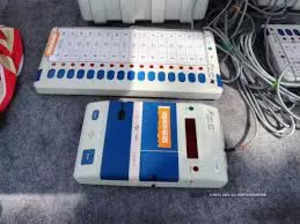Synopsis
The Haryana election results have led the Congress to question varying EVM battery levels across polling stations, suggesting potential impact on poll outcomes. Experts and former election officials clarify that battery charge variations do not influence vote recording or counting results, emphasizing secure EVM protocols.
 Agencies
AgenciesThe Haryana election results have drawn focus to EVMs once again with the Congress pointing fingers at varying EVM battery levels across different polling stations and how this may have impacted poll results. Anubhuti Vishnoi details the EVM battery protocol and operation.
EVM and Battery
An EVM consists of two units — a Control Unit (CU) and Balloting Unit (BU). Both are linked with a five-meter-long cable. The Control Unit, which records the polled votes, runs on a power pack (alkaline battery) of 7.5 volts. During the counting of votes from EVMs, only the Control Unit(s) is required.
On the top portion of the CU, there is provision for displaying the information and data recorded in the machine, like the number of candidates, total number of votes polled, votes polled to each candidate etc. This portion is called the ‘Display Section’ of the CU.
Below the display section, there are two separate compartments. On the left is the ‘battery compartment’ for installing the power pack (battery) and on the right side lies the ‘candidate set compartment’ for setting the number of candidates contesting the particular election, including NOTA. Below the battery and candidate set compartments there is a ‘result section compartment’.
Priming the EVM Battery
After finalisation of the names of the contesting candidates, the ballot papers for EVMs are printed. Thereafter, the returning officers prepare the EVMs in the presence of the candidates or their agents or their authorised representatives and the Election Commission’s Observer.
Multilevel thread sealing of various compartments/sections of EVMs is done by the Returning Officer as part of this process — a thread seal is put in place for the ‘Candidate Set’ and power pack (battery) section of the CU, after setting of the number of contesting candidates and installation of battery is done. The alkaline battery in the EVM Control Unit is commissioned and sealed in the presence of candidates. Thread sealing of the ballot paper screen of the Balloting Unit after fixing of the ballot paper is also done before the second randomisation of the CUs/BUs for allotment to specific polling stations.
Battery Failure Protocol
In case the power pack of the CU does not function properly or shows low battery indicator, the power pack is replaced by the presiding officer in the presence of the polling agents and sector officer. The battery section of CU with the address tag is again sealed and a signed report on the same is submitted to the ECI.
Battery-level Changes
The EVM battery comes with adequate charge to last two days, keeping in mind both the polling day and counting day, officials said. While every battery pack starts at near 100% charge when it is commissioned, the battery charge levels change depending on the extent of usage in mock poll to actual poll and can often come down by counting day.
Point of View
“When the mock poll is conducted, while most candidates are allowed 5-10 votes per machine, provision is there to allow up to 15 votes, if so insisted by the candidate or polling agent. Also, the battery usage will be impacted by the number of candidates involved. So, if 28 candidates are in the fray and go for mock poll, up to 300 votes may have to be cast as per the drill. This figure varies across polling stations and explains different levels of battery charge. So, the idea that battery levels can impact counting results is completely absurd,” former Chief Election Commissioner OP Rawat told ET.
A former Chief Electoral Officer also pointed out that vote is already recorded and VVPAT verified, so it is illogical to think that battery levels can change it in any way.
Battery Vs Cord
The EC opted for a battery-run EVM. So, it is a standalone in every way and not dependent on electric connection at polling stations. Rawat said this was felt necessary to preclude any allegation that the EVM was manipulated in any way through a connection provided at the polling station, mostly government buildings.

